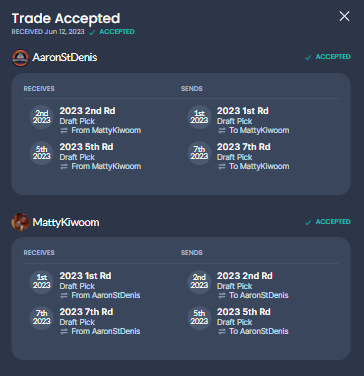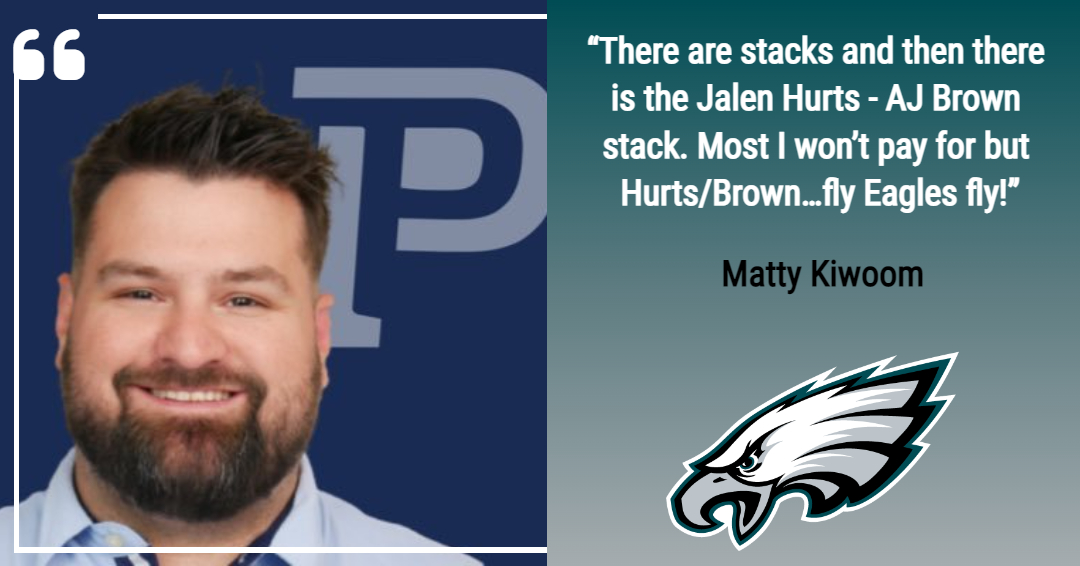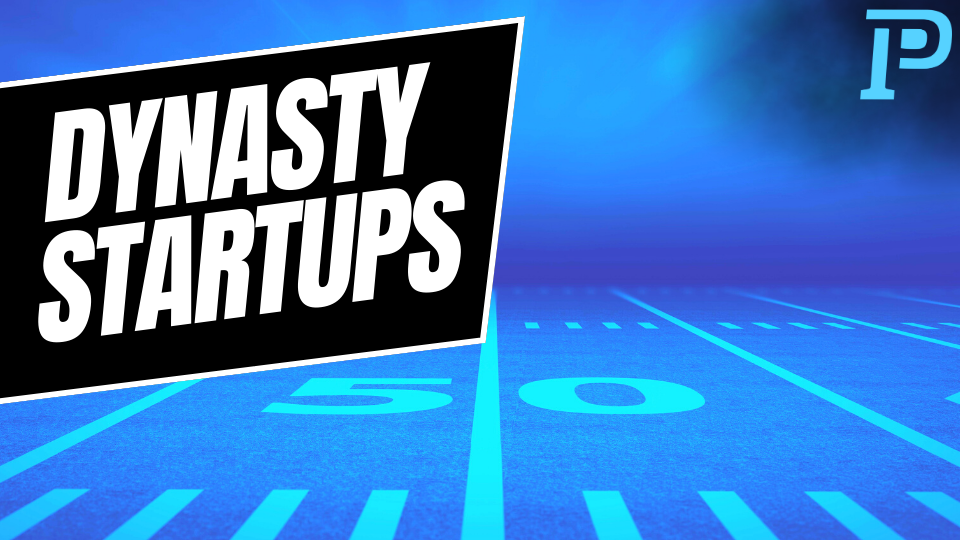NFL rookie drafts have come and gone. Dynasty startup season is in full swing. In preparation for dynasty season, the staff over at PlayerProfiler conducted a Dynasty Startup Draft/1QB. The startup was a 12-team 1QB league with a third-round reversal. In this league, managers have to start 1QB, 3 RB, 4 WR and 2 TE.
In addition to these deep starting rosters, it was also full-PPR scoring and six-point per passing touchdown. The draft board can be seen below for reference as we break down the first five rounds of the draft, complete with a full breakdown of the trades.

The full draft board can be viewed on Sleeper by clicking on the link here.
Round 1
The Status Quo
We start with the usual. Young, stud receivers go off the board 1-2. In this instance, Chase goes before Jefferson, but it’s the dealer’s choice. The more interesting development here is that after taking Chase as the 1.01, Jon Adams turned around and flipped him in a trade I will break down in a minute. Once Chase went off the board first, Tyler Knaeble had the easy decision to select Justin Jefferson.
Next up was Matt Kelley, who opted to shift gears and snatch up the RB1 on the board in rookie mega-star Bijan Robinson. As far as dynasty startup drafts go, Robinson is the easy RB1 and there was no arguing this pick.
After the only healthy, young superstar running back was scooped up, the draft shifted back to young wide receivers. Ahaan Rungta made a pretty standard pick by selecting CeeDee Lamb, but Brendan Llewellyn went slightly off the board and chose Amon-Ra St. Brown, an interesting choice with the likes of A.J. Brown still on the board.
Riverboat Matty
Pick 1.06 is where things really start to go sideways. In a 1QB league, especially one with such deep starting lineups, I anticipated most managers would punt quarterback. Perhaps indicative of the death of the “Late Round QB” draft strategy, we see three quarterbacks fly off the board in the back half of the first round. Dustin Hogue started it off by pressing the button on Patrick Mahomes.
Seth Diewold would select next, and his pick would be the other young, stud running back. This one was coming off a season-ending injury in Breece Hall. If he is able to fully heal from his ACL injury, he would be in the top tier of dynasty running backs with Robinson. Although his selection here will make it tough to be a 2023 contender as he may miss time to start the season. A productive struggle build may be incoming for Seth.
Off the Rails
This is where the draft goes right off the rails. I don’t advocate trading up in the first round of dynasty drafts. The value is not normally there. Additionally, I really don’t like doing it to select a quarterback in a 1QB league.

Matty Kiwoom-Aaron St. Denis Blockbuster Trade
Matty Kiwoom went for broke. When all was said and done, he had formed an elite stack consisting of Jalen Hurts and A.J. Brown. His first-round stack strategy was clearly the way he wanted to go. It’s a bold way to start a draft. Only time will tell if it pays off.

Matty Kiwoom on his blockbuster trade.
The draft got back on the rails for a brief moment. Jonathan Lange selected the first tight end off the board in Travis Kelce. He is getting up there in age. However, with two tight ends in your starting lineup, it’s not difficult to see why he pulled the trigger on the best tight end in fantasy football history.
Mike Valverde would pull the trigger on Jonathan Taylor at 1.11. Next, we saw the final quarterback of Round 1 taken when Jason Allwine shockingly selected Joe Burrow over Josh Allen. The Burrow selection was an interesting one, and we will see if it pays off.
Round 2
A Mix of Young and Old
After a first-round that resembled the wild west, the second round settled into a much more reasonable place. The TE2 went off the board in Mark Andrews. He would have been my choice for TE2 in this startup. Getting him as the second tight end off the board is a great value. The rest of the second round consisted of the elite running backs that were too old to go in Round 1. Additionally, this round included a mix of receivers. Some are young studs set to likely to become elite wide receivers. Others are already elite wide receivers who are on the tail end of their career.
Tyreek Hill, Cooper Kupp and Davante Adams are all proven producers who are capable of a WR1 overall season. Their selection in Round 2 likely pushes their managers into a win-now build. The teams selecting Garrett Wilson, Chris Olave, Jaylen Waddle, and Devonta Smith all have slightly less upside but allow their managers the flexibility of a more long-term approach. The lone running back selected in the second round who is not an older, proven asset was Jahmyr Gibbs. While Gibbs certainly has youth on his side, he is far riskier than Christian McCaffrey, Saquon Barkley and Austin Ekeler.
Differing Strategies
The second round is where we really start to see a split in philosophy. Several teams clearly valued youth and are building a team that hopes to be a contender for years to come. Others, like myself, decided to take the value of the older and more proven players and chose a win-now build.
I was the only manager not to make a first-round pick. Matty Kiwoom made a deal with me for the 1.09. I don’t mind the talent I was able to scoop up in this round. However, this move gave me two choices. Once, I could take younger, unproven players. The second choice was selecting veterans who are creeping towards the age cliff. I opted to go with the veterans in the end. While I expect to field a competitive team with this build, I’m not sure it’s the approach I prefer to take in most startup drafts.
Round 3
The Third Round Reversal
The third-round reversal presented a unique opportunity for some of the managers who drafted older players in the first two rounds to select younger players in this round. Typically, I would have been forced to draft another veteran like Davante Adams as the rest of the young talent flies off the board. However, with the reversal, I was given a chance to strike earlier.
This round also brought the drafting of the young, upside-backs. I opted to go with Josh Jacobs who has had the highest level of production of the group to date. Najee Harris, Kenneth Walker, and Travis Etienne were the other three running backs selected. While all of them have the same potential as Jacobs, they all carry significantly more risk.
The best wide receiver left on the board was far and away Tee Higgins. Seth scooping him up here feels like excellent value. After Higgins, we have two young receivers (Jaxon Smith-Njigba and Drake London) with a lot to prove and a veteran (Davante Adams) in the twilight of his career. London and Smith-Njigba both have the potential to develop into Adams. It will likely take some time for them to get there.
Return of the Quarterback
After seeing three quarterbacks fly off the board in the first round, we then saw an entire round go by without another quarterback selected. Josh Allen fell all the way to pick 3.02.
Lamar Jackson lasted until pick 3.09. Kyle Pitts was also taken in this round by the Podfather. We will see if the rookie phenom is able to return to his pre-injury form. For the purposes of this league where you have to start two tight ends, you can’t go wrong with a young, athletic tight end at the beginning of his career.
Round 4
The Youth Movement
T.J. Hockenson was the first player off the board in Round 4. Hockenson would be joined by Dallas Goedert and George Kittle. We also saw a trio of very young receivers mixed in Round 4 as sophomore Christian Watson was joined by rookies Quentin Johnston and Jordan Addison.
Running Back Value
For the teams that opted not to simply draft young receivers, Derrick Henry, Nick Chubb, Rhamondre Stevenson, and Tony Pollard were all available and were a far greater value than the aforementioned receivers. Henry and Chubb have far less time left in their careers. Those players found themselves on win-now rosters with other veterans.

Tyler Knaeble on Justin Herbert.
Now, we saw two more quarterbacks go off the board. Justin Hebert would go at pick 4.02 and Justin Fields at pick 4.07. Both are excellent value. If either Herbert of Fields had made it to me in this round, I would have smashed a hole in my phone trying to hit the draft button.
Round 5
Grab a Quarterback While You Can
We see the last of the elite quarterbacks fly off the board in round five with Anthony Richardson, Trevor Lawrence and Deshaun Watson all being selected. Richardson is easily the riskiest of the three, but in a 1 QB league, you can afford to take more risk and shoot for the upside. Jonathan’s Team made the pick and he will almost certainly draft multiple quarterbacks later in the draft to have a backup plan in the event Richardson is a bust. Watson and Lawrence are good values here.
Time for Some Upside
The theme in Round 5 was high upside plays with no floor. The likes of D.J. Moore, Michael Pittman, Deebo Samuel, and Jerry Jeudy were selected here and all have shown the potential to be top-ten receivers. A miss on these picks could effectively set your team back for several years and ruin the chances of contending in year one.
The running backs taken in Round 5 didn’t offer much more safety than the receivers. D’Andre Swift and Dobbins have both shown flashes of being elite backs, but both have battled injury for the better part of their careers. Aaron Jones has been elite for much of his career, but with Aaron Rodgers moving on and his age coming into play, he certainly has more years behind him than in front of him.
I opted to take the other back who is closer to the end than the beginning and selected Joe Mixon. His ADP has plummeted as many managers anticipate the Bengals cutting him due to legal concerns, but I’ll buy the discount and take a chance. The youngest of the bunch is Buccaneer’s running back Rachaad White, who is being drafted on potential opportunity alone. If the Buccaneers add another body, he could lose significant value.
Follow me on Twitter: @FFMadScientist






